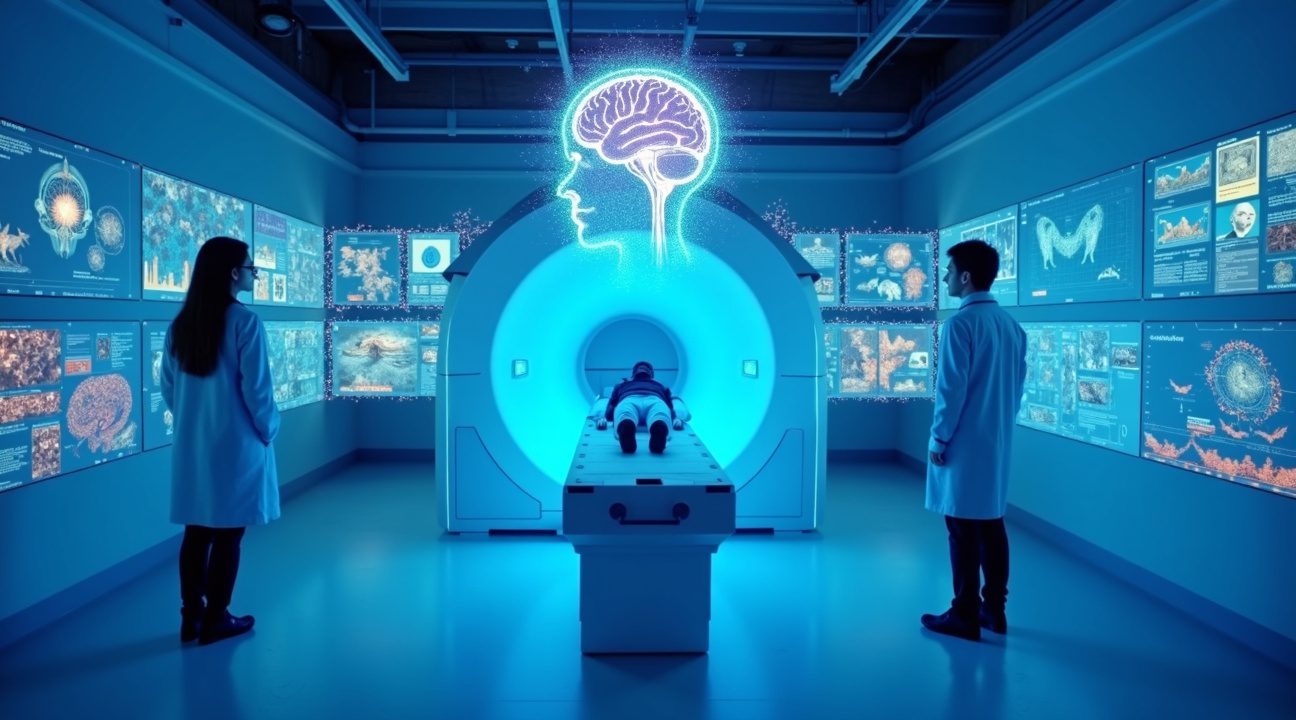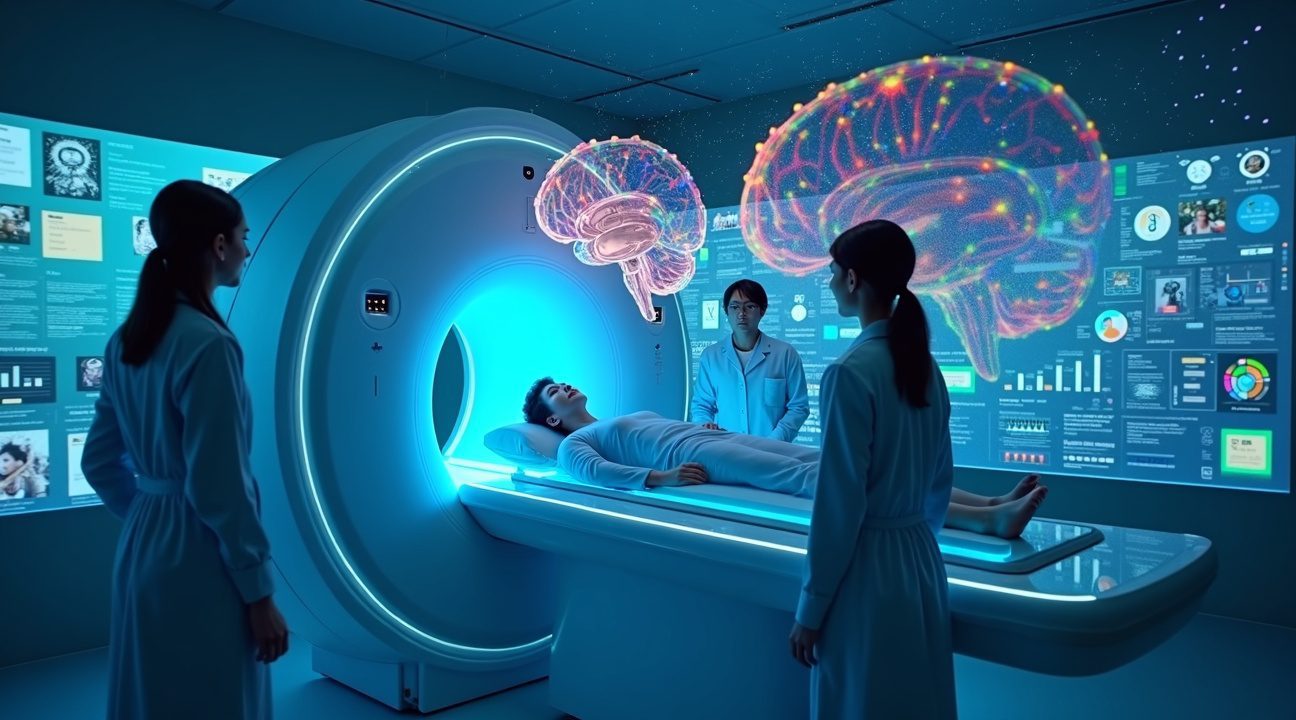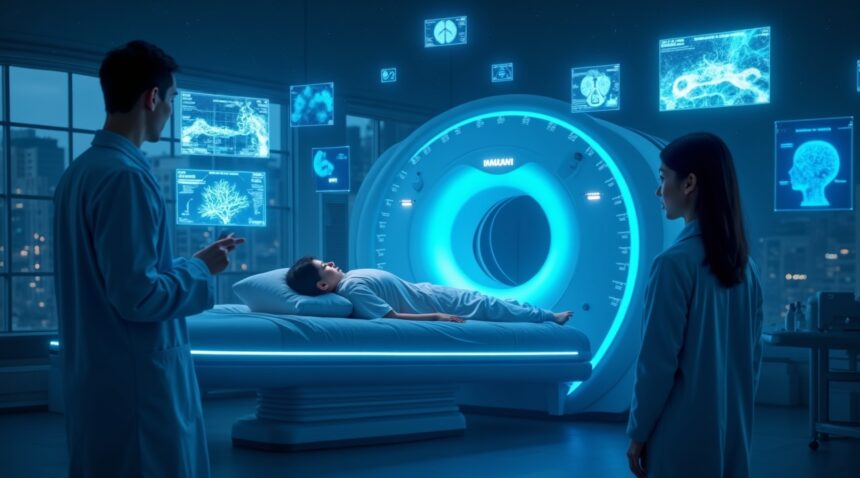Scientists at Japan’s ATR Computational Neuroscience Laboratories have made significant progress in brain imaging technology, developing a system that decodes elementary visual elements from dreams using functional MRI and machine learning.
Key Takeaways
- The system decodes blood flow patterns in specific brain regions during REM sleep to detect basic visual categories, such as people or objects, rather than full dream narratives or emotional content.
- Current visual reconstructions appear as blurry still images that represent general categories, not detailed scenes or fluid motion, challenging the “movie-like playback” claims in some media reports.
- The technology depends on expensive equipment, including fMRI scanners costing millions, and requires individualized training data, making consumer-level applications currently unfeasible.
- Subjects must remain entirely motionless during MRI sessions while sleeping, a requirement that introduces unnatural conditions which could influence the authenticity of dream content.
- Potential future applications include medical and neurological therapies such as treating nightmares, exploring consciousness, or enabling communication for paralyzed patients, although practical use is likely years away.
Further Reading
To learn more about this technology, you can visit ATR’s official website for detailed research updates and ongoing projects.
Revolutionary Brain Imaging Can Decode Visual Elements from Dreams — But It’s Not Movie Playback
The breakthrough coming from Japan’s ATR Computational Neuroscience Laboratories represents a significant step forward in brain imaging technology, though it’s quite different from the “dream recording device” described in viral headlines. Prof. Yukiyasu Kamitani’s research team has developed a sophisticated system that combines functional MRI (fMRI) with machine learning algorithms to decode limited visual elements from brain activity during sleep.
This neural decoding approach works by analyzing blood flow patterns in specific brain regions during REM sleep, then using AI reconstruction techniques to identify basic visual categories. The researchers achieved roughly 60% accuracy for general dream content, with success rates climbing above 70% when focusing on specific visual elements like people, animals, or objects. These statistics come directly from the Kyoto-based laboratory’s published findings.
What the Technology Actually Captures
The system successfully reconstructs brief flashes of still images tied to brain patterns, but it doesn’t produce the cinematic dream replays that many news stories suggest. Fact-checkers like Snopes have rated viral claims about “movie-like playback” as a mixture of truth and exaggeration. The technology identifies whether someone dreamed about a car, a face, or a building, but it can’t recreate the narrative flow or emotional context of dreams.
Current limitations include:
- The need for participants to remain perfectly still inside an MRI scanner during sleep cycles, making natural dreaming difficult.
- The decoded images appear as fuzzy, abstract representations rather than clear pictures.
- The machine learning algorithms require extensive training data from each individual before they can accurately interpret that person’s unique brain patterns.
Scientists continue advancing this field by improving AI reconstruction techniques and developing more sensitive brain imaging equipment. Future applications might include:
- Treating nightmares
- Studying consciousness
- Helping paralyzed patients communicate through visual imagery
However, the technology remains years away from creating detailed video recordings of our nighttime adventures.
The research does open fascinating possibilities for understanding how our brains process visual information during sleep. As imaging technology becomes more precise and machine learning algorithms grow more sophisticated, researchers may eventually decode more complex dream elements. For now, though, this Japanese innovation offers valuable insights into brain function rather than a window into our sleeping minds’ private theaters.

How Scientists Map Brain Patterns to Visual Categories During Sleep
I’ve discovered how Japanese researchers are revolutionizing our understanding of dreams through sophisticated brain mapping techniques. Scientists collect brain activity data using functional magnetic resonance imaging (fMRI) while subjects view various static images during their waking hours. They repeat this process during REM sleep when dreams reach their most vivid state, creating a comprehensive database that links unique fMRI activation patterns with different visual categories.
The process begins with participants lying inside fMRI machines while viewing hundreds of colored static images, letters, and objects. Each visual stimulus creates distinct voxel patterns in the brain, which researchers carefully catalog. These waking brain responses serve as the foundation for understanding how the mind processes visual information.
Training Advanced Machine Learning Models
Machine learning models receive training to match these fMRI patterns with specific items or categories that appear in dreams. The algorithms analyze the statistical relationships between brain responses and visual stimuli, building sophisticated neural decoding capabilities. This technology represents a significant advancement beyond earlier attempts at artificial intelligence applications in neuroscience.
During sleep experiments, researchers monitor participants throughout REM cycles and strategically awaken them at optimal moments. Subjects provide immediate verbal reports describing their dream content, which scientists use to validate and refine the accuracy of their decoding algorithms. These verbal labels become crucial reference points for improving the reconstruction process.
The decoding results appear as sequences of blurry, still images rather than continuous or seamless video playback. Current technology limitations prevent the creation of smooth, movie-like dream recordings. Instead, scientists reconstruct visual categories as individual frames that represent the general content of dream imagery.
Researchers expose subjects to extensive arrays of visual stimuli to strengthen their statistical mapping capabilities. The brain responds differently to various colors, shapes, letters, and objects, creating distinct neural signatures that algorithms can learn to recognize. This comprehensive training approach allows the system to identify broader visual categories rather than specific detailed images.
The validation process involves comparing reconstructed visual categories with participants’ verbal dream reports. Scientists analyze discrepancies between predicted and reported content to improve their models’ accuracy. This iterative refinement process gradually enhances the system’s ability to decode dream imagery correctly.
Current limitations prevent the technology from capturing fine details or emotional nuances within dreams. The reconstructed images remain abstract representations of general visual categories rather than precise reproductions of dream content. However, this breakthrough represents a fundamental step forward in understanding how the sleeping brain processes visual information.
The implications extend beyond dream research into broader neuroscience applications. Scientists can now observe how visual processing differs between conscious and unconscious states, providing insights into memory consolidation and cognitive function during sleep. This research methodology could eventually influence treatments for sleep disorders and memory-related conditions.
Future developments may improve image clarity and expand the range of decodable dream elements. Researchers continue refining their machine learning algorithms and exploring advanced neuroimaging techniques to enhance reconstruction quality. The current system successfully demonstrates that dream content can be partially decoded and visualized, marking a historic achievement in neuroscience research.
The Japanese team’s work bridges the gap between subjective dream experiences and objective scientific measurement. Their functional magnetic resonance imaging approach provides quantifiable data about previously unmeasurable mental phenomena, opening new research possibilities in consciousness studies and sleep science.

What Scientists Have Actually Achieved Versus Media Headlines
The gap between scientific achievement and media portrayal becomes particularly stark when examining Japan’s groundbreaking MRI dream research. Scientists have successfully demonstrated category-level decoding capabilities, identifying broad classifications within dream content with reported accuracies ranging from 60% to 70%. These categories include basic elements such as person, house, or text, representing a significant breakthrough in neuroscience.
However, the actual reconstructed outputs bear little resemblance to the cinematic dream playback often suggested in headlines. Current technology produces blurry, montage-like sequences that lack any coherent narrative structure. I find these reconstructions fascinating from a scientific perspective, yet they remain far removed from the immersive experiences many expect.
Current Limitations and Realistic Expectations
Several critical capabilities remain beyond current technological reach, creating substantial gaps between expectation and reality:
- High-fidelity narrative experiences cannot be reconstructed using existing methods
- Conversations and dialogue remain completely inaccessible through current brain imaging
- Audio components of dreams cannot be captured or replayed
- Subjective thoughts and emotions stay locked within individual consciousness
- Complex storylines and dream logic cannot be translated into visual formats
These limitations stem from fundamental constraints in how brain imaging technology interprets neural activity. Current systems rely on statistical correlations rather than direct neural translation, producing category-level associations instead of detailed scene representations. The reconstructions, best described as fuzzy and indistinct, offer glimpses into brain activity patterns without providing the rich detail many anticipate.
Research teams continue working to increase clarity and move toward more detailed visual representations. Some recent advances show promise in technological innovation, though practical applications remain years away. Unlike consumer devices that might eventually emerge, current MRI systems require specialized laboratory conditions and extensive computational processing.
The montage-like quality of current reconstructions reflects the brain’s complex information processing during sleep states. Neural networks fire in patterns that don’t translate directly to visual coherence, creating outputs that appear more abstract than literal. Scientists must interpret these patterns through sophisticated algorithms that identify probable visual elements rather than exact imagery.
Progress continues at research institutions worldwide, with some teams exploring connections between dream content and other emerging technologies. Just as robotic innovations push boundaries in unexpected ways, dream research challenges conventional understanding of consciousness and memory.
The indistinct nature of current reconstructions actually provides valuable insights into how dreams form and function. Rather than disappointment, these blurry outputs represent remarkable progress in understanding the sleeping brain. Each decoded category brings researchers closer to comprehending the neural mechanisms underlying dream formation.
Future developments may eventually bridge the gap between current capabilities and public expectations. However, realistic timelines suggest that narrative dream playback remains a distant goal rather than an imminent reality. The complexity of translating neural activity into coherent visual experiences requires advances across multiple scientific disciplines.
Current achievements deserve recognition for their scientific merit rather than criticism for falling short of science fiction expectations. Category-level decoding represents a foundational step in brain-computer interface development, even if the results appear underwhelming compared to media portrayals. These fuzzy reconstructions mark the beginning of a new chapter in neuroscience research, not the culmination of dream recording technology.
Current Accuracy Rates and Technical Limitations
Popular summaries suggest that dream decoding achieves approximately 60% accuracy overall, with impressive improvements reaching over 70% accuracy for specific visual categories such as objects or people. These statistics sound promising, but I must clarify what they actually represent. The figures reflect the probability that decoding models correctly predict items mentioned in subjects’ verbal reports, not that the technology reproduces objective recordings of dreams themselves.
Snopes and other analytical sources emphasize a crucial distinction: these aren’t complete, continuous recordings of dream experiences. Instead, the output reflects object-level predictions derived from trained machine learning models that interpret brain activity patterns. The difference between prediction and recording fundamentally changes how we should understand this technology’s capabilities.
Real-World Implementation Challenges
Currently, no consumer-facing “dream replay” device exists in the marketplace. The research depends entirely on expensive, lab-based fMRI scanners that cost millions of dollars and require carefully structured experimental protocols. Each subject undergoes individualized model training, making the process highly specialized and time-intensive. Unlike consumer technology that works out of the box, dream decoding requires extensive calibration for each person’s unique brain patterns.
The reconstructions correlate with verbal dream descriptions but only provide a partial and probabilistic picture of mental activity. Scientists stress that these outputs shouldn’t be interpreted as definitive representations of subjective experiences. Instead, they represent educated guesses based on statistical patterns learned from training data.
Technical limitations extend beyond accuracy rates. The high-end MRI dependence means experiments must occur in controlled laboratory environments, eliminating the natural sleep conditions where most dreams happen. Subjects often need to remain still for extended periods while machines capture brain activity, which can affect sleep quality and dream content itself.
Probabilistic decoding represents another significant constraint. The system makes predictions based on learned associations between brain patterns and visual concepts, but it can’t distinguish between actual dream content and random neural activity that coincidentally matches trained patterns. This uncertainty makes it impossible to verify whether decoded images truly represent what someone experienced during sleep.
The technology faces additional hurdles in temporal resolution. Dreams unfold dynamically over time, with rapidly changing scenes and narratives, while current decoding methods capture static snapshots of brain activity. Bridging this gap between the flowing nature of dreams and the discrete nature of current analysis remains a major challenge.
Individual differences in brain structure and function also limit universal applicability. What works for one person may fail completely for another, requiring personalized training datasets and model adjustments. This variability makes it unlikely that standardized dream decoding systems could work reliably across diverse populations without extensive customization.
The research shows promise but operates within significant technical boundaries that popular media often overlooks. While scientists continue making incremental improvements, the gap between current capabilities and science fiction portrayals of advanced technology remains substantial. Understanding these limitations helps set realistic expectations for what dream decoding can and cannot accomplish in its current form.
Current accuracy rates represent just the beginning of this scientific journey. The 60-70% figures demonstrate proof of concept rather than practical implementation readiness. As researchers refine their methods and technology advances, these numbers may improve, but fundamental challenges around subjective experience interpretation and real-time processing continue to shape the field’s development.
Future Applications and Current Speculation
The potential applications for this groundbreaking dream decoding technology extend far beyond its current capabilities. Researchers envision transformative uses across multiple fields, though most remain in the theoretical stage. I see three primary areas where this technology could make significant impacts: scientific research, therapeutic interventions, and creative industries.
Scientific and Therapeutic Possibilities
In neuroscience and psychology, this technology offers unprecedented opportunities to explore consciousness research and understand how dreams function within our minds. Scientists could finally examine the mysterious mechanisms that drive our sleeping thoughts, potentially unlocking secrets about memory consolidation and emotional processing.
Mental health assessment represents another promising avenue. Therapists might use dream data to better understand their patients’ subconscious concerns and fears. Some researchers speculate about PTSD/nightmare therapy applications, where clinicians could analyze recurring traumatic dreams to develop more targeted treatment strategies. However, these therapeutic uses remain entirely theoretical and haven’t undergone clinical trials for validation.
The technology could also revolutionize how medical professionals approach sleep disorders. By analyzing dream content patterns, doctors might identify early signs of neurological conditions or track recovery progress in brain injury patients. Still, I must emphasize that these applications exist purely in the speculation phase.
Creative and Entertainment Applications
Entertainment applications present fascinating possibilities for artists and storytellers. Film directors could potentially use decoded dream imagery as inspiration for surreal scenes, while writers might draw from subconscious narratives to craft unique storylines. Visual artists could transform dream sequences into paintings or digital art, creating works that truly represent the human unconscious experience.
Musicians might even compose pieces based on the emotional patterns found in dreams. Some have suggested that this technology could inspire innovations similar to how animated storytelling has evolved in recent years.
Game developers could create immersive experiences based on actual dream logic, potentially revolutionizing how we approach interactive entertainment. These creative applications, while exciting to consider, remain largely speculative given the technology’s current limitations.
The ultimate goal involves improving scene-level decoding capabilities. Researchers aim to progress from today’s blurry categorical representations to complete, detailed reconstructions of dream scenarios. This advancement would transform the technology from a research curiosity into a practical tool with real-world applications.
Despite the excitement surrounding these possibilities, I recognize that this remains early-stage research with significant technical hurdles ahead. The gap between current capabilities and envisioned applications requires substantial scientific breakthroughs and ethical considerations before any practical implementation becomes reality.

Privacy Concerns and Technology Comparison
The groundbreaking ability to record and replay dreams raises unprecedented questions about neuroprivacy and data governance that researchers have yet to fully address. While media coverage focuses on the fascinating technical capabilities, the ethical implications of accessing someone’s most private mental experiences demand serious consideration.
Critical Privacy and Consent Issues
Participant consent becomes extraordinarily complex when dealing with subconscious content that individuals cannot control or even remember. Traditional informed consent models fall short when researchers can potentially access memories, fears, and desires that dreamers themselves aren’t aware they’re experiencing.
Data ownership presents another thorny challenge—who controls neural information once it’s extracted and decoded? The potential for misuse extends far beyond academic research, raising concerns about:
- Government surveillance
- Corporate exploitation
- Unauthorized access to someone’s deepest thoughts
I find these governance gaps particularly concerning given how rapidly the technology advances. Current research protocols may not adequately protect participants from future applications they can’t yet imagine. The decoded neural information could theoretically be used to infer:
- Personality traits
- Mental health conditions
- Predictive behavior patterns
These are details individuals never consented to reveal, making the ethics of dream decoding a pressing matter.
Technology Distinctions and Capabilities
Media reports frequently confuse this Japanese research with EEG-based consumer devices, but the distinction matters significantly for both capabilities and privacy implications. The research relies on fMRI technology, which offers superior spatial resolution compared to EEG systems. This higher fidelity allows researchers to decode object-level visual content from brain activity with remarkable precision—something current EEG devices simply cannot achieve.
EEG-based consumer devices, while more accessible and portable, currently lack the spatial resolution required for accurate dream reconstruction. These systems excel at:
- Detecting broad neural patterns
- Identifying states of sleep, relaxation, or focus
But they cannot capture the detailed visual information necessary for meaningful dream playback. The technology gap resembles the difference between viewing a pixelated thumbnail and examining a high-resolution photograph.
fMRI provides detailed insights into brain activity by measuring blood flow changes in specific regions, allowing researchers to map which areas activate when processing different visual stimuli. This precision enables the correlation between neural patterns and specific images or concepts that appear in dreams. However, fMRI systems remain impractical for general consumer use due to their:
- Substantial cost
- Massive size
- Requirement for specialized facilities
The accessibility versus fidelity trade-off presents interesting implications for privacy protection. While fMRI’s limitations currently restrict dream recording to research settings, advancing technology could eventually miniaturize these capabilities. EEG devices might seem less threatening due to their current limitations, but their widespread availability and improving accuracy could pose different privacy risks as the technology evolves.
Consider how robotic technology has rapidly advanced in recent years—similar acceleration in brain-computer interfaces could quickly transform today’s research curiosity into tomorrow’s consumer reality. The current technical barriers provide only temporary protection for our neural privacy.
Future developments might bridge the gap between EEG accessibility and fMRI precision, potentially creating portable devices capable of detailed dream recording. Stanford University research in related fields suggests that seemingly impossible technologies often become mainstream faster than anticipated.
The implications extend beyond individual privacy to societal concerns about neural surveillance and thought policing. As major tech acquisitions demonstrate, powerful technologies often concentrate in the hands of large corporations or governments. Dream recording capabilities could fundamentally alter the balance between mental privacy and external oversight, making current data protection debates seem trivial by comparison.
Sources:
Snopes – “Japanese Scientists MRI Dreams”
Times of India – “Scientists create a unique device to record human dreams”
The Business Standard – “Japanese scientists invented device to record and playback your dreams”
Daily Sun – “Japanese scientists invented device to record and playback your dreams”
Sun Blog – “Dream Recording Machine”
News 24 Online – “Japanese researchers make device that can record and play back your dreams”
Undiknas Blog – “Dream Recorder Technology: The Latest Innovation from Japan”


